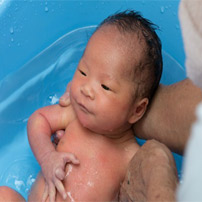Child Health and Safety
April 27, 2017Consumer Product Safety Commission Approves New Safety Regulations for Infant Tubs
 According to the Consumer Product Safety Commission (CPSC), accidental death by drowning is the second leading cause of death for children under the age of five. While pools can be especially dangerous for children in this age group, infant tubs can be as well.
According to the Consumer Product Safety Commission (CPSC), accidental death by drowning is the second leading cause of death for children under the age of five. While pools can be especially dangerous for children in this age group, infant tubs can be as well.
Infant bath tubs are typically placed in sinks, on top of surfaces or put into adult-sized bathtubs. There are many different types and models of infant tubs including inflatable, foldable, bucket-style and even infant tubs with “spa features” such as separate handheld showers and whirlpool settings. Infant tubs are designed for children specifically and can provide support to them in a variety of positions during supervised use.
The CPSC’s new standard takes into account that since January of 2004, there have been nearly 250 incidents involving infant tubs. Sadly, 31 of these incidents culminated in the fatality of a child, while the remaining 216 were non-lethal but many involved injuries.
Certain patterns, referred to by the CPSC as “hazard patterns”, contributed most strongly to these infant fatalities and injuries. Hazard patterns such as leaving a child alone in a tub, sharp edges, product failures, mold/allergy issues, entrapment issues, slippery surfaces and battery-related incidents were among the most frequently reported. Although some patterns resulted in drowning, others resulted in lacerations, bumps and bruises and respiratory problems, to name a few.
The new federal standard will implement many safety requirements, such as latching and locking mechanism requirements, drowning and fall warnings, markings and instructions and static load testing. Static load testing investigates the ability of a foundation to maintain its shape under weight. The CPSC wants to ensure that infant tubs are safely designed, can bear the appropriate amount of weight and come equipped with warnings and alerts that allow for parents and caregivers to use them in the safest manner possible.
Once infant baths are being given, the CPSC provides some overall, safety guidelines. We have compiled these below:
- Do not ever leave a child alone in a tub or near any kind of water. Child drowning can occur quickly and silently, even if there is a minimal level of water present.
- A child needs to be supervised by an adult, not another child or teenager. Many incidents of drowning and injury have occurred while under the care of a minor.
- When an infant is bathing, keep the tub within arm’s reach distance. If you must walk away because of an emergency, take the infant out of the tub.
- Because drowning can have serious consequences after only seconds, it is important to learn CPR. You can take a course or even learn online.
It is important to remember that most of the instances of drowning and injury occurred because a parent or caretaker left the child unattended, even if only for a moment. While it may seem like no big deal to go and grab a towel, attend to another child in the house or answer a quick phone call, this truly can result in a child’s serious injury or death.
Bathtub seats and rings are particularly controversial for this very reason. Although they are still on the market and perhaps fairly popular, the CPSC has reported that over 12% of at-home child fatalities were the result of using these products. The purpose of these seats and rings are to hold slightly older infants, typically over the age of 6-8 months, in upright positions while bathing. But, because the product seems to promote a sense of security, they increase a parent or caregiver’s likelihood of leaving a child unattended. These seats and rings can tip over, or a child can slip out of them.
Although some groups have asked the CPSC to ban baby bath seats and rings, the commission has made it clear that these products are not child safety devices, but instead merely “bathing helpers”. In addition, the CPSC has enacted federal standards for the development and design of these products as well. The standards are somewhat similar to the infant tub standards, including mandates such as stability standards to prevent the product from tipping over, tighter leg openings so that children do not slip out and clear, large warning labels. As always, the commission works to protect the safety of children and promote awareness as well as policy on ways that consumers can help.
You can read the CPSC’s new federal safety standard on infant tubs here. Even though the standard was released in late March and will come into effect sometime later this year, it is necessary to pay attention to the safety tips now. Please keep the CPSC’s safety guidelines in mind while bathing your infant, and remember to never leave any child unsupervised while they are in or near water. If you travel any further than an arm’s length distance from a bathing infant, simply remove them from the tub and take them with you to avoid the unnecessary risk of drowning or injury.
Philadelphia Personal Injury Lawyers at Galfand Berger, LLP Helping Injured Victims
If you have any legal questions or concerns, call the Philadelphia personal injury lawyers at Galfand Berger, LLP. With offices located in Philadelphia, Reading, Lancaster and Bethlehem, we serve clients throughout Pennsylvania and New Jersey. To schedule a consultation, call us at 800-222-8792 or complete our online contact form.
 Google Screened
Google Screened
